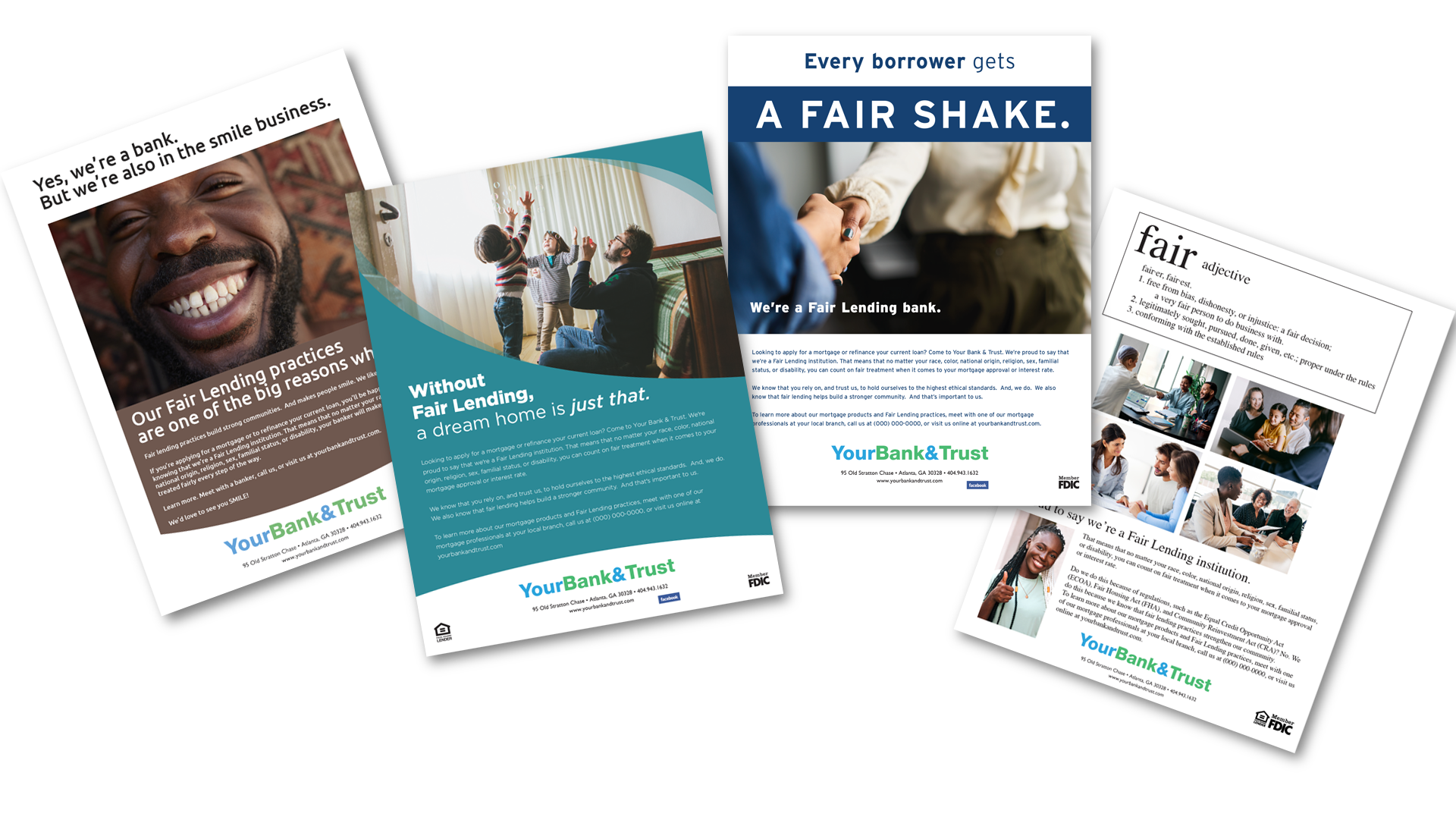
Community banks are the bedrock of local economies, fostering financial growth and stability within their neighborhoods. As cornerstones of trust and service, these institutions hold a significant responsibility not only to provide financial support but also to ensure equity and fairness in their lending practices. Implementing and steadfastly following Fair Lending practices isn't just a regulatory necessity; it's a fundamental commitment that strengthens community ties and fosters inclusivity.
What is Fair Lending? Fair lending prohibits lenders from considering your race, color, national origin, religion, sex, familial status, or disability when applying for residential mortgage loans. Fair lending guarantees the same lending opportunities to everyone, and that the process is based solely on the individual’s financial qualifications. How is this guarantee enforced? The federal Fair Housing Act protects an individual’s fair lending rights. The Office of Fair Housing and Equal Opportunity enforces the federal Fair Housing Act and state and local enforcement agencies enforce fair housing laws that are substantially equivalent to the federal Fair Housing Act.
Lending discrimination can occur at any stage of a home purchase or refinancing process. For example, if a lender refuses to make a mortgage loan because of your race or ethnicity, or if a lender charges excessive fees to refinance your current mortgage loan based on your race or ethnicity, the lender is in violation of the federal Fair Housing Act.
Understanding Fair Lending Practices
In order to facilitate the practice of fair lending, community banks are subject to various regulations, including the Equal Credit Opportunity Act (ECOA), Fair Housing Act (FHA), and Community Reinvestment Act (CRA). Compliance with these regulations is essential to prevent discriminatory practices and promote fair access to credit and banking services. When put into practice, Fair Lending processes actively prevent discriminatory lending practices, including redlining (denying credit based on a neighborhood's demographics), steering (directing borrowers to less favorable loan products), and pricing disparities based on non-financial factors.
The Importance for Community Banks
As a community bank, upholding Fair Lending practices reinforces your reputation as a fair and ethical institution, one that represents the best of its community. This fosters trust among customers, investors, and the broader community, enhancing the bank's standing as a reliable financial partner. But trust isn’t the only benefit to Fair Lending. Fair access to credit fuels economic growth within the community. When banks ensure equitable lending, they empower both individuals and small businesses, facilitating entrepreneurship, job creation, and overall economic development.
As we all know, community banks are uniquely positioned to understand the needs and challenges specific to their community. Implementing Fair Lending practices allows them to tailor services and lending products that cater to the diverse requirements of their community members.
Why market your Fair Lending practices?
Simple. Marketing your Fair Lending practices demonstrates your commitment to fairness, equality, and social responsibility; the cornerstone to your reputation in the community. It’s a way to:
- distinguish yourself from both the non-bank and the large national banks
- engage customers beyond financial transactions
- Invite your customers to be part of an ethical banking journey, aligning their values to your commitment to fairness and non-discrimination
- reinforce the personalized service you’re known for
- communicate your bank’s dedication to providing equal opportunities for credit access
- empower underserved communities, encouraging those who live in them to seek financial assistance without fear of discrimination
- reinforce your role as a driver of positive social change by promoting economic equality
- enhance your reputation as an ethical institution
Effective Marketing Strategies for Fair Lending Practices
Educational Campaigns and Workshops
Hosting seminars and workshops on fair lending educates your community, showcasing your bank's commitment to Fair Lending practices, while empowering your customers with an understanding of their rights.
Digital and Social Media Messaging
Leveraging digital platforms to communicate fair lending messages broadens your bank’s reach. Social media advocacy campaigns can disseminate information effectively and quickly, while engaging a wide audience. Use your social media platforms and messaging to communicate your educational programs and your community partnerships.
Community Partnerships and Outreach
Collaborating with local organizations and participating in community events reinforces the bank's commitment to fairness. Such partnerships demonstrate a shared dedication to promoting inclusivity and equal access to credit.
Challenges and Considerations
Resource Allocation and Budgeting
Implementing marketing campaigns focused on Fair Lending practices requires dedicated resources and budgeting. Community banks might need to allocate additional funds and personnel.
Navigating Regulatory Compliance
Ensuring that marketing efforts comply with fair lending laws and regulations is essential. It is critical that your bank navigate these regulatory frameworks while effectively communicating their Fair Lending initiatives.
The promise of AI and Fair Lending
Artificial Intelligence (AI) has revolutionized the banking industry, offering efficiency, accuracy, and personalized services. However, while AI presents a myriad of benefits, its application in lending decisions can potentially exacerbate biases and lead to unfair lending practices, such as:
Biased algorithms can result in discriminatory lending outcomes. For instance, AI might favor certain demographics or penalize others based on historical data, leading to unequal access to credit.
- Reinforcement of Socioeconomic Disparities
If AI algorithms consider factors correlated with socioeconomic status, such as neighborhood demographics, they might inadvertently reinforce existing disparities, limiting opportunities for marginalized communities.
- Legal and Reputational Risks
Unfair lending practices, whether intentional or unintentional, pose legal and reputational risks to banks. Lawsuits and damage to reputation can arise if AI systems are found to perpetuate discrimination.
What next? Strengthening Communities through Fairness
Marketing fair lending practices isn’t just about compliance; it’s a demonstration of a community bank’s commitment to its core values and the community it calls home. By communicating their practices transparently, community banks can continue to foster trust, promote inclusivity, and reinforce their positive impact within their communities.
About Bank Marketing Center
Here at bankmarketingcenter.com – one of the industry’s most well-regarded providers of professionally-designed marketing materials to local banks – our goal is to help you with that topical, compelling communication with customers that will help you build trust, relationships, and revenue. Like these ads on our portal that you can use to market your Fair Lending practices.

To view our marketing creative, both print and digital – ranging from product and brand ads to social media and in branch signage – visit bankmarketingcenter.com. You can also contact me directly by phone at 678-528-6688 or via email at nreynolds@bankmarketingcenter.com. As always, I welcome your thoughts.